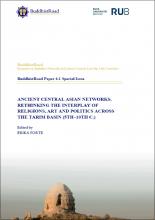BuddhistRoad Paper 6.1. Special Issue: Ancient Central Asian Networks, ed. Erika Forte. “Brahmanical Deities in Foreign Lands: The Fate of Skanda in Buddhist Central Asia”
Synopsis
The relationship between Brahmanism and Buddhism is a very inspiring field of inquiry, with which scholars have so far dealt applying different, often antithetic, methodological approaches and attitudes of mind. The question of the 'borrowing' of Brahmanical deities by the Buddhist theistic system is one of the major issues of the debate. On this occasion, it will be addressed from an iconographic viewpoint, with a focus on the Brahmanical god Skanda/Kārttikeya, a multifaceted and metamorphic deity in its own original milieu. Formerly a demon, later promoted to divine rank, Skanda plays a role in Buddhism as well. An analysis of the diverse iconographic contexts in which his depictions occur, from Gandhāra to Central Asia, offers interesting clues to a possible explanation of his presence in the local Buddhist repertoires.
Chinese Translation
婆罗门教与佛教之间的关系是一个非常有启发性的研究领域, 迄今为止, 学者们运用不同的, 甚至是对立的方法论和思维角度来研究这个问题. 佛教有神论系统对婆罗门教神祇的 “借用” 是争议的主要方面之一. 此次, 我们将着眼于在其原始背景多面且善变的婆罗门教的神祇韦驮 (Skanda/Kārttikeya), 从图像学的角度探究这一问题. 韦驮以前是一个恶魔, 后来晋升为神祇, 在佛教中也发挥着作用. 从犍陀罗到中亚韦驮不同的图像背景, 为解释他在当地佛教语境中的存在提供了有趣的线索.

Downloads
Published
Categories
License

This work is licensed under a Creative Commons Attribution-NonCommercial-ShareAlike 4.0 International License.

